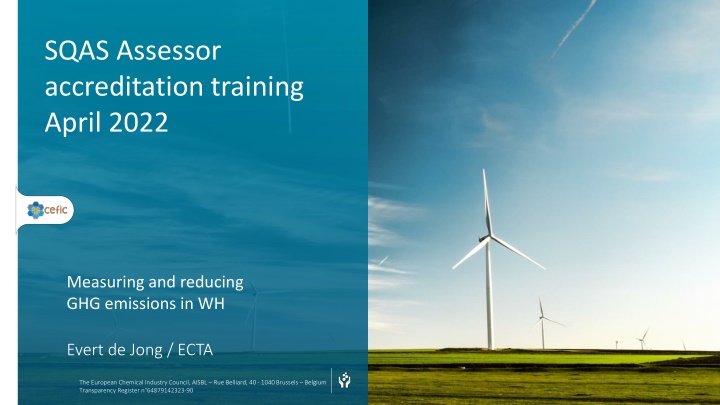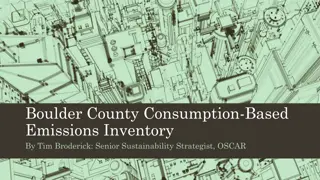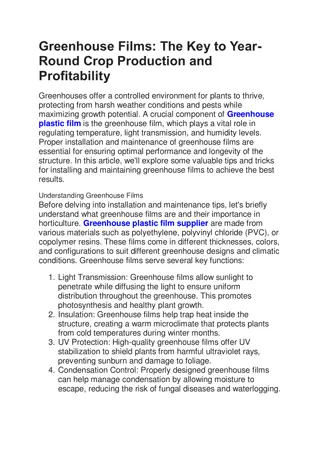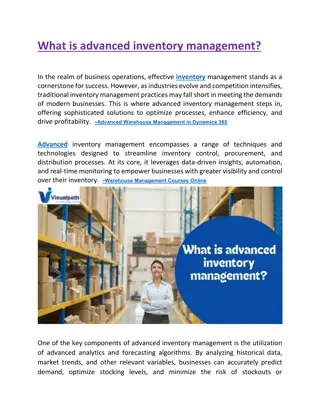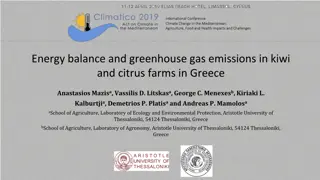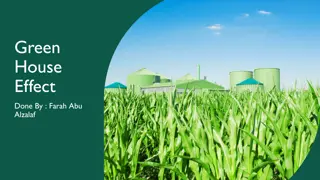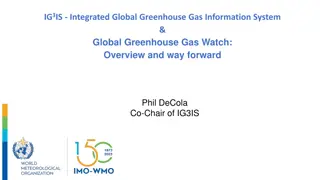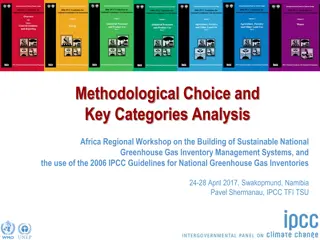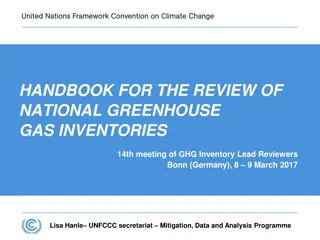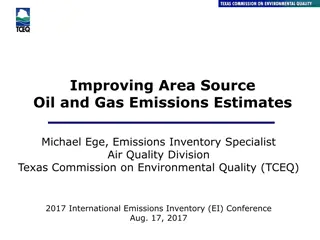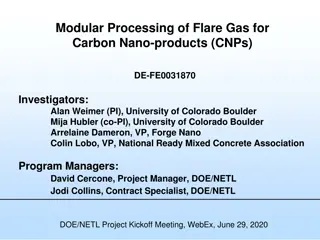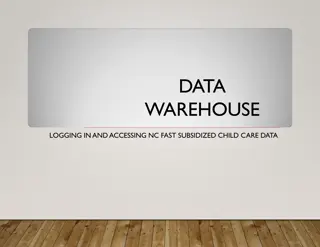Greenhouse Gas Emissions Management in Warehouse Operations
The SQAS Assessor accreditation training in April 2022 focused on measuring and reducing greenhouse gas emissions in warehouse operations. The content covers emission questions, scope of emissions, energy consumption examples, disaggregation of emissions, emission intensity calculation, and strategies for emission reduction in a warehouse company. It highlights the importance of measuring and managing greenhouse gas emissions to promote sustainability in the supply chain industry.
Download Presentation

Please find below an Image/Link to download the presentation.
The content on the website is provided AS IS for your information and personal use only. It may not be sold, licensed, or shared on other websites without obtaining consent from the author.If you encounter any issues during the download, it is possible that the publisher has removed the file from their server.
You are allowed to download the files provided on this website for personal or commercial use, subject to the condition that they are used lawfully. All files are the property of their respective owners.
The content on the website is provided AS IS for your information and personal use only. It may not be sold, licensed, or shared on other websites without obtaining consent from the author.
E N D
Presentation Transcript
SQAS Assessor accreditation training April 2022 Measuring and reducing GHG emissions in WH Evert de Jong / ECTA The European Chemical Industry Council, AISBL Rue Belliard, 40 - 1040 Brussels Belgium Transparency Register n 64879142323-90
Content 1. The emission questions in the SQAS 2022 Warehouse module 2. Scope 1, 2 & 3 emissions in a warehouse company 3. Energy consumption examples in a basic warehouse company 4. Energy consumption examples for additional services at a warehouse company 5. Disaggregation of emissions in a warehouse company 6. Total emissions of a warehouse company 7. Calculation of emission intensity 8. Emission reduction in a warehouse company 9. Conclusions 10. References Page 2
1. The Emission Questions in the SQAS 2022 Warehouse Module 10.3 Measurement and Management of greenhouse gas (GHG) emissions 10.3.1 Scope 1: Emission measurement of fuel consumed 10.3.2 Scope 2: Emissions from electricity 10.3.3 Disaggregation of energy consumptions 10.3.4 Scope 3 10.3.5 Calculation of Total emissions (Scope 1, 2 and 3) 10.3.6 Calculation of emission intensity 10.3.7 Consolidating and reporting emissions 10.3.8 Reducing emissions Page 3
2. Scope 1, 2 & 3 for a warehouse company Scope 1: TTW emissions of all fuel burned during the activity: Gas or diesel as fuel to operate cargo handling equipment (e.g., forklift trucks) Gas or diesel as fuel for other equipment used at the warehouse site (e.g., site trucks, heaters Scope 2: WTT emissions from all electricity in the facility used, e.g.: Electrical forklifts Lighting, IT equipment Scope 3: The emissions of subcontractors who get their orders directly from the Warehouse company, e.g., subcontracted warehousing; subcontracted road transport for internal moves; or for movement of stock from chemical plant to warehouse. Page 4
3. Energy consumption examples in a basic warehouse company Gas or Diesel driven OUT IN STORAGE Forklifts (gas or diesel driven) Terrain trucks (gas or diesel driven) Heating of buildings / warehouses Other Lifting Equipment Electricity consumption: Electric forklift / terrain trucks or other electric equipment Lighting (terrain, offices, technical installations, locker room, ) Office equipment (PC s, photocopiers, printers, ) Office / Warehouse Air Conditioning / Heating / Ventilation Page 5
4. Energy consumption for additional services in a warehouse company SOME EXAMPLES Road Transport (owned) - reference to SQAS TS presentation Road Transport (subcontracted) - reference to SQAS TS presentation Heating / Cooling (of Loaded Transport - reference to SQAS TC presentation Equipment or Stored Products or For Other Reasons, e.g, sprinkler) Specialized equipment - Fire fighting installations, incl pumps, etc. / Truck Weighbridges Drumming / Filling / Bagging Equipment - Pumps, Machinery, Compressors, etc SILO s - Dust Management and Cleaning Tools Page 6
5. Disaggregation of emissions in a warehouse company Small/medium Warehouse sites: supplier invoice to quantify the energy consumption Gas / LPG invoices Diesel invoices Electricity invoices Bigger Warehouse sites: based on individual counters where possible Different counters for electricity consumption Sometimes separate diesel/gas/lpg counters for the different activities * necessary when other activities take place on the same site * if no separate counters: estimation as % of the total consumption by equipment is acceptable Page 7
6. Total Emissions of a Warehouse Company In principle it is possible to simply calculate the total emission: scope 1 totals scope 2 totals scope 3 totals + Total emissions = /////// The calculation of the emissions total makes sense if the order package of the assessed company is uniform. If the orders are not all requiring the same work (read: need the same emission per ton, or per pallet, or per cbm), the use of the outcome of the total emissions does not make sense. Page 8
7. Calculation of Emission Intensity (1) The challenge: How does a warehouse company calculate this with a multitude of subactivities? In principle it is possible to calculate in a simple way: Annual Total emissions / Annual Total tonnage handled (this does not do right to the activities variation) OUT IN STORAGE Page 9
7. Calculation of Emission Intensity (2) A better handle to get direction for improvement opportunities, especially for more diverse warehouse activities: Calculate per sub-activity If more diversified activities: Calculate emission per order package / per accumulated activities totals This last method also makes it easier to review the results of your efforts to improve Assessor: Look at the pragmatic/realistic administrative choices the warehouse company has made still staying in line with the general requirements of the questions Page 10
7. Calculation of Emission Intensity (3) Calculate per sub-activity If more diversified activities: Calculate emission per accumulated activities totals / per order package Basic WH, basic order package Multi-activities WH Basic order package Multi-activities WH Multi Activ. package Forklift trucks emission share Forklift trucks emission share Forklift trucks emission share Office emission Office emission share Office emission share Lighting emission sgare Lighting emission share Lighting emission share Other non-basic activities emission share Intensity = Total Emission / tonnage Intensity = Package Emission Total / package tonnage Intensity = Package Emission Total / package tonnage Page 11
8. Some emission reduction examples in a warehouse company Change of equipment From diesel truck to electric truck From gas heater to electric heater Automatic light switches Use of LED lights in- and outside Change of Supplier From non-green to green supplier of electricity From diesel to electricity supplier Create your own energy supply Roof solar panels Own wind turbines Behaviour of people Training of staff into more efficient use of energy, e.g.: - driver training - lights off discipline Correct Maintenance schedules Stay informed about better technology If allowed within the environmental license Note: the final technologic solutions to reach the 2030/2050 goals are not there yet! Page 12
9. Conclusions 1. There can be a large variety of energy consumption units in a warehousing company; scope 1, 2 and 3 are all possible. 2. In most cases there is no separate registration of the consumption per activity. Separate registration per site activity may be possible. Most scope 1 and 2 calculations are based on the invoices of the suppliers. 3. There is no specific guideline for chemical warehousing more general sources of information can be easily found (e.g., Fraunhofer document) 4. For a lot of activities in the warehouse operations, CO2 emissions can be reduced. Still: to reach the goal of zero logistic emissions new technology will be required Page 13
10. References https://learnproject.net/ https://www.smartfreightcentre .org/en/ http://publica.fraunhofer.de/starweb/ser vlet.starweb?path=epub.web&search=N- 532019 Page 14
References Are heat pumps used in industry? Heat pumps are well known for being an eco-friendly way of heating or cooling homes. Used in an industrial context, they not only save fuel costs, but can contribute to making a company's heat supply carbon neutral and open up new business opportunities. Heat Pump Danish city decarbonizes heat supply with Supplier Name Danish utility company DIN Forsyning has commissioned us to supply a turnkey technology solution for heat generation, featuring two Supplier Name heat pump systems. The system will replace the current coal- fired plant and will supply around 100,000 local inhabitants with approximately 235,000 MWh of emission-free heat annually. Page 15
10. References Chapter The performance of the backfills of the borehole heat exchanger of the ground source heat pump system in cooling dominated region of China ByW. Ma, J. Hao, C. Zhang, F. Guo, H. Wen Page 16
Thank you for your attention! April 2022 Evert de Jong / ECTA The European Chemical Industry Council, AISBL Rue Belliard, 40 - 1040 Brussels Belgium Transparency Register n 64879142323-90
